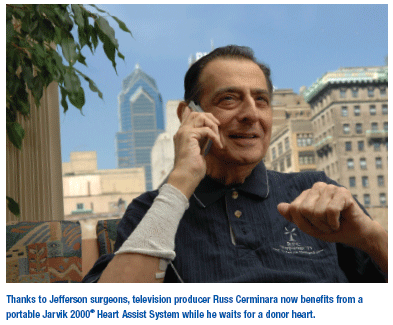
Recommended Citation
(2007)
"Heart Transplant Program Offers a New Lease on Life,"
Jefferson Surgical Solutions: Vol. 2:
Iss.
1, Article 1.
Available at:
https://jdc.jefferson.edu/jss/vol2/iss1/1
Included in
Russell Cerminara is not someone you would readily identify as a patient in a hospital, let alone someone on the heart donor list. Casually dressed and exceedingly well groomed, he lounges comfortably in the waiting area outside his room on the 5th floor of the Gibbon Building – the Cardiac Unit – at Jefferson University Hospital. If it weren’t for the IV stand, and the small black Jansport backpack that holds a device pumping his heart, you’d never know he’d spent the last decade battling a life-threatening heart condition and been in the hospital since April.

Every bit the image of a successful television producer, Mr. Cerminara takes calls on his blackberry when not doing physical therapy or interacting with other patients and family members. He’s working to gain enough strength to go home while he waits for a heart, which could be a while given his O blood type.
Medicare Certified...the highest quality indicator for a transplant program, based on the number of transplants and clinical outcomes.
On May 24, 2007, he received a Jarvik 2000® Heart Assist System. This is the smallest and simplest of the axial flow pumps in existence right now – the latest technology in LVADs (Left Ventricle Assist Devices), invented by Dr. Robert Jarvik. Rather than taking over for the heart, the Jarvik assists the patient’s weakened left ventricle to pump blood throughout the body. Jefferson was the first hospital in Philadelphia to offer the groundbreaking device, which has not yet been approved by the FDA as standard treatment.
Mr. Cerminara is but one success story in a young but impressive and growing Heart Transplant Program at Jefferson – which was Medicare Certified after only a very short time. This is the highest quality indicator for a transplant program, based on the number of transplants and clinical outcomes as well as skill and professionalism of the medical and surgical teams. For patients with serious cardiac failure, this makes Jefferson a financially viable option for treatment.
The surgical team benefits from a new surgical suite that contains miniature equipment as well as state-of-the-art video monitoring devices. James Diehl, MD, Director of the Division of Cardiothoracic Surgery, says that this makes more seamless procedures possible that integrate endoscopy as well as minimally invasive cardiac surgery techniques. "What is more," he says, "everyone in the operating room can see the procedures with exceptional clarity."
The quality of care speaks for itself. "I’m going to make a television show about this disease, treatment process, and this device," says Mr. Cerminara. "Because the public in general is very unaware of it, like I was." His continued recovery is sure to make this possible, and will make for another of the compelling and positive stories to which he continues to be so devoted to telling.
The Surgeon Speaks
"There are several surgical advantages to the Jarvik Heart for a patient like Russ Cerminara. Like all LVADs, it is implanted with the use of a heart and lung machine, but it is less invasive and more gentle on the heart itself. Patients rarely need blood transfusions. And it can be implanted through the left chest, which is less risky for the patient because it avoids creating dangerous scar tissue in the middle chest."
"While Russ had battled heart failure for many years, he had been successful with various other treatments. It was only when we saw that he was no longer responsive to these therapies that it became clear how limited his options really were."
"He agreed it was time to begin the evaluation process for a heart transplant, and just a week before he was to come in to start the tests, he was rushed to the hospital and we decided the LVAD was necessary. At that point it was lifesaving. And now, as Russ gains strength, we’re even more optimistic about the potential outcomes when a heart does become available."
Scott C. Silvestry, MD
Director, Heart Transplantation and
Cardiac Mechanical Assist Program

